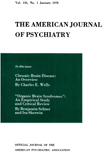CEREBRAL MORPHOLOGIC CHANGES IN MONKEYS SUBJECTED TO A LARGE NUMBER OF ELECTRICALLY INDUCED CONVULSIONS (32-100)
Abstract
Five groups of Maccacus rhesus monkeys were subjected to 32-100 electrically induced convulsions with currents of 90 volts and duration of current flow of 0.3 sec. and 0.5 sec.; two different sized electrodes were used. The following findings were observed in animals sacrificed at varying intervals (from ½ hour up to 1½ years) following the last induced convulsion.
Functional and morphologic changes mostly related to the vascular system as indicated by increased permeability of the blood vessel walls (distension of the perivascular spaces surrounded at times by mild reactive glia proliferation, or compound granular corpuscles, and particularly diapedesis of blood elements).
The neuronal changes were mostly of the reversible type. When more intense and more frequently repeated current and longer duration of current were applied, occasional minute petechial hemorrhages resulted. This seems to support the contention that the degree of the lesions is somewhat proportional to the intensity of the electric current, the duration of the current flow and, to a lesser extent, the number of shocks.
The histologic alterations were more pronounced and more frequently observed in the areas traversed by the main path of the current.
In comparing some of the neuronal changes in experimental animals with the same occurrence in the control group, one must not only evaluate the qualitative changes but also the quantitative ones.
Differing somewhat from reports in human material, our conclusions are derived from the study of numerous blocks and at times of a whole hemisphere serially sectioned of experimental material, thus allowing detection of changes which may escape a more cursory investigation in human material.
Functional vasomotor changes may be at the base of the favorable therapeutic results reported in human cases. Reversible histometabolic and structural changes as well as permanent structural damage may be at the base of the more or less transitory mental symptoms of the organic reaction type which follow, at times, electroshock therapy.
Access content
To read the fulltext, please use one of the options below to sign in or purchase access.- Personal login
- Institutional Login
- Sign in via OpenAthens
- Register for access
-
Please login/register if you wish to pair your device and check access availability.
Not a subscriber?
PsychiatryOnline subscription options offer access to the DSM-5 library, books, journals, CME, and patient resources. This all-in-one virtual library provides psychiatrists and mental health professionals with key resources for diagnosis, treatment, research, and professional development.
Need more help? PsychiatryOnline Customer Service may be reached by emailing [email protected] or by calling 800-368-5777 (in the U.S.) or 703-907-7322 (outside the U.S.).



